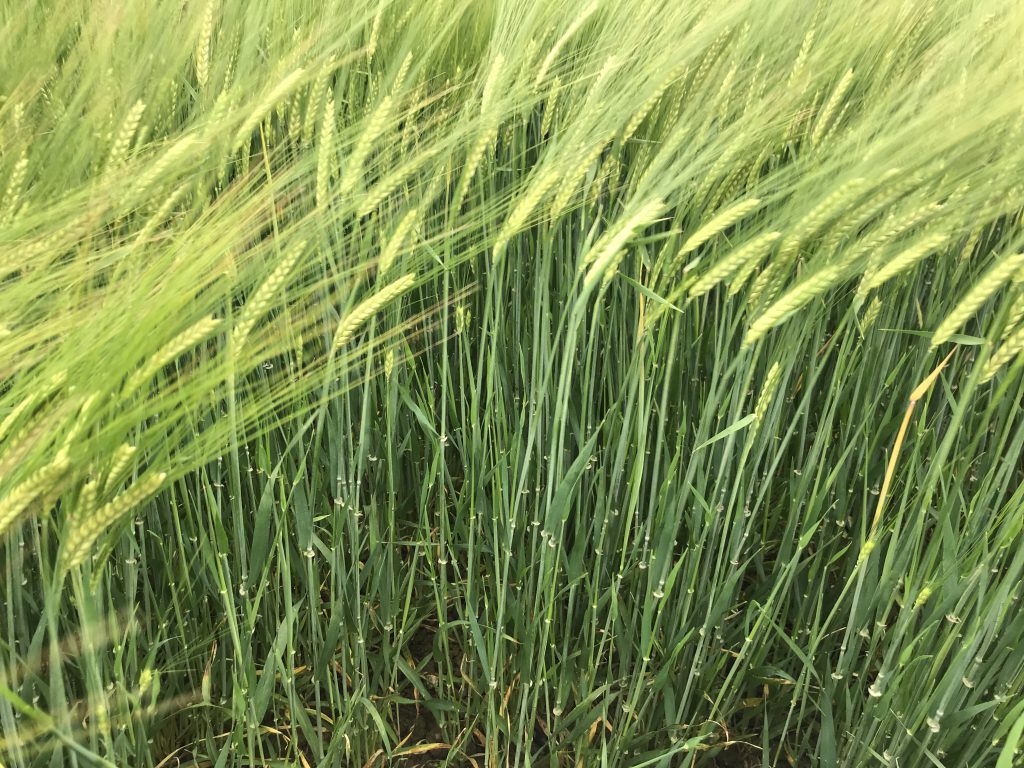The Drummonds’ trial site in Termonfeckin, Co. Louth, is a massive asset to the company’s growers and agronomists.
Brian Reilly runs independent trials which examine agronomy programmes and allow different products and varieties to be tested before being recommended for use to a farmer.
Top of the list at Drummonds is nutrition. As more and more plant protection products fall off the list, and EU strategies push for a reduction in pesticide use, Drummonds continues to look at how nutrition can benefit agronomy programmes.

Brendan O’Reilly and Brian Reilly inspecting a crop of oats at the Drummonds’ trial site in Termonfeckin, Co. Louth
Many plots that AgriLand viewed had just received nutrition – no fungicides. An integrated approach is what’s needed as the industry moves forward and that is what is happening at Drummonds.
Brian Reilly explained to AgriLand how the company’s agronomists take leaf samples and send them for analysis. The results are back in 72 hours and crops are given a targeted nutrition programme. The deficiencies spotted in the leaf analysis are then treated.
All vegetable and potato farmers take these leaf samples and it is now common practice in many cereal crops as well.
“It’s helping us to target growers’ investment on the correct nutrition at the correct timings,” Brian explained.
Growers know that the money being spent is going where it is needed, instead of applying a blanket nutrition product.
Now let’s be clear, fungicides are still a key part of agronomy programmes, but preventing plant stress and feeding plants is essential in reducing the incidence of disease and for getting the most out of a fungicide product.
In the plots, some of the nutrition-based programmes stood out.
In many of the company’s recommendations to growers, bio-stimulants are used. Brian added that when using fungicides “it’s all about how it’s carried”.
Products like Phylgreen are used, which Brian notes should be applied “little and often” while adding that it helps to carry the fungicide in the plant.
It takes the stress out, especially for ramularia or septoria; it’s a healthier plant.
Drummonds also test farmers’ water and add a water conditioner where needed. There are lots of factors at play that, when tweaked, can prevent or lower disease and improve the efficiency and effectiveness of plant protection products.
There is also a focus on varieties. Drummonds puts a lot of work into sourcing varieties to suit its growers, which are high yielding and have good resistance to disease. Torp in winter wheat has been one such success.
“On the high-scoring varieties, there’s an opportunity to reduce spend. We as agronomists have to look at that going forward,” Brian noted.
Some images of the trial plots below show where nutrients have been used in the agronomy programmes.
“Nutrition is key, especially in a year that’s dry,” Brian added.
The first plot shows Torp winter wheat treated with Magnitech at the head spray having received Velogy and Ascra at T1 and T2.
The plot below shows a plot of winter wheat treated with Velogy and Ascra at T1 and T2, along with Phylgreen at T3.
This image (below) shows winter wheat which received Velogy and Ascra at T1 and T2 and Super K Plus at T3.
A lot of recommendations on barley include magnesium at the flag leaf stage and Brian commented that “magnesium on barley always pays off”.
The plots in the pictures below show winter barley crops in early July treated with Magnitech, Phylgreen, and Super K.
Looking at this picture (below), plot 18 (on the right) received Magnitech at T2 along with the standard two-spray fungicide programme, while plot 19 (on the left) received the same fungicide programme and also received Super K Plus at T2.
The winter barley plots below both received a standard two-spray fungicide programme. However, plot 16 (on the right) also received an application of Phylgreen at T1 and plot 17 (on the left) received Phylgreen at both T1 and T2.

This plot of winter oats received no fungicides. Over the course of the season it received two nutrition prescriptions from Drummonds and looked very clean.
Varieties
Drummonds always place an emphasis on varieties and sources many of its own. Torp, featured in the wheat plots above and in the main image at the top of this article, is one example of a wheat variety available from Drummonds which is performing well on the recommended list.
AgriLand took a look at the variety trials on-site earlier this month and some of the stand out names are listed below.
Highway
Highway is a promising spring barley variety coming from Drummonds and has two years of trials completed with the Department of Agriculture. It had relative yield scores of 102 and 101 in 2018 and 2019 respectively. Its parentage will be familiar to many; it is a cross between Sparkle and Quench.
Skyway
Skyway has just one year of trials completed and its high relative yield score of 106 in 2019 comes as no surprise with RGT Planet in its genes.
Normandy
On winter barley varieties Normandy is coming down the tracks. It has two relative yield scores available from the Department of Agriculture. It had a rating of 99 in 2018 and 101 in 2019.





